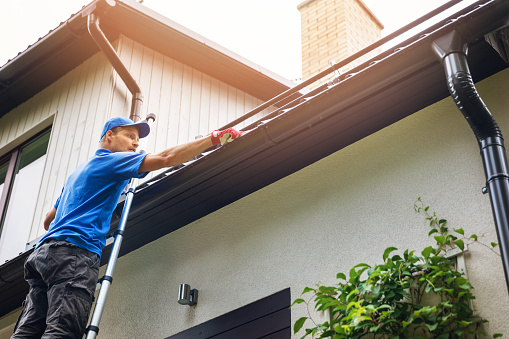Your home-sweet-home probably didn’t come with an owner’s manual listing all the basics you need to know to keep it in good repair, but that certainly would have been helpful.
Here’s a list of 22 steps for you to follow to become better acquainted with your home. They cover everything from the roof to the foundation, and will help you to understand what home maintenance is necessary, as well as give you a better idea of when you can do things yourself and when you should call a professional.
Safety
1. Smoke Alarms
Install a smoke alarm on every level of your home. Make sure there’s one in the basement, in each bedroom and outside each sleeping area, the National Fire Protection Association recommends. It’s a good idea to avoid placing them in or near bathrooms or the kitchen, as the heat from a hot shower or the stove might trigger them repeatedly.
Once a month, test each alarm by pressing the “test” button. It should produce a loud beeping noise. If it doesn’t, or if the sound is faint, change the alarm’s batteries. Your owner’s manual should provide specific details on the testing procedure. If you can’t find your owner’s manual, you can look for a copy online by typing the make and model of the alarm into a search engine.
If a smoke alarm begins to chirp on its own, this may be another indication that you need to replace the batteries immediately. Otherwise, plan to replace the batteries in each alarm at least annually, unless the alarm has 10-year, non-replaceable batteries.
Replace smoke alarms every 10 years. If, after you’ve replaced the batteries on an alarm, it still doesn’t sound, replace it then as well.
2. Carbon Monoxide Detectors
Carbon monoxide (CO) is a colorless, odorless gas that is potentially lethal. Its concentration can build up in your home when a car is left running in the garage, gas-burning appliances are operated or gas- or wood-burning fireplaces are used, just to name a few examples. Therefore, you should place a carbon monoxide detector on every floor of your home.
CO alarms have varying shelf lives, so replace as often as directed by the manufacturer. As with smoke detectors, if you cannot find the owner’s manual, you can search for it online.
3. Fire Extinguishers
Place a fire extinguisher on every floor of your home and in the kitchen. Be sure to choose extinguishers rated ABC. These will work on fires involving:
- Common household items, such as cloth and wood (A)
- Liquids, such as oil and gasoline (B)
- Electrical equipment, such as appliances and faulty wiring (C).
Familiarize yourself with the steps involved in putting out a fire—before a fire starts:
- Pull out the pin and hold the extinguisher with the nozzle pointed away from you.
- Aim the fire extinguisher at the base of the flames.
- Squeeze the lever on the handle slowly and evenly.
- Sweep the nozzle back and forth to put out the fire.
Every month, inspect each extinguisher to ensure that the gauge is full, the nozzle is unclogged and the cylinder isn’t leaking or damaged. If you notice any issues, replace the extinguisher. Otherwise, plan to replace your extinguishers at least every 10 years.
4. Grease Fires
If you’re faced with a grease fire, never throw water on it as it could cause an explosion. The first thing you should do is turn off the burner. If that doesn’t take care of the fire, use a fire extinguisher or carefully place a metal (not glass) lid over the fire to smother the flames.
Never carry a burning pan outside because you might “spill” flames, causing a larger house fire. And as with all fires, call 911 for assistance if you cannot immediately subdue it.
5. Fire Escape Plan
Draw up a fire escape plan for your home. For each room in your house, identify two escape routes. Doors are the most obvious options, but first-floor windows that can be opened easily are good too.
Everyone in the house should know the plan. Practice it and agree on a safe meeting spot outside your property.
6. Storms
Draw up a storm safety plan. Designate a safe area in your home in which you can take shelter if a hurricane, tornado or other severe storm strikes. This area should be a storm shelter, a basement or a windowless room in the interior of the house (e.g., a bathroom).
You should also use surge protectors, whether or not a storm is in the forecast. After all, storms aren’t the only causes of power surges. Purchase and use them to safeguard your computer, stereo and other costly electronics from power surges. The higher the number of joules of protection a surge protector offers, the better.
Regular Inspections
7. Roof
The National Roofing Contractors Association (NRCA) recommends that you have your roof inspected twice a year. The inspector will look for signs that your roof needs repair, so you can have it fixed before a leak occurs. Signs of a problem include broken or missing shingles, loose seams and worn flashings.
The NRCA advises that you have your roof inspected by a roofer who is bonded and insured. If your state, county or city requires licensing, be sure to check that the roofer is, in fact, licensed; the state will typically set the requirements and license the roofer.
If your area does not require licensing, other entities may offer licensing programs that can help consumers vet roofers. For example, in Texas, a state that doesn’t require licensing of roofers, the Roofing Contractors Association of Texas offers a licensing program for roofers. To learn about the requirements in your area, start by checking with the local government office that issues residential building permits.
8. Chimney
The Chimney Safety Institute of America recommends having your chimney inspected once a year, and that you do this even if you don’t use your fireplace. Animals can carry debris into your chimney, which can lead to chimney deterioration and compromise your safety.
Have a certified chimney sweep or inspector carry out your annual inspection and make any necessary repairs.
9. Electrical System
The Electrical Safety Foundation International (ESFI) recommends having an electrical system inspection if your home is over 40 years old, you recently purchased or renovated a home or you installed new appliances. Hire an electrician who is licensed in your state to perform the inspection. The electrician will look for outdated knob-and-tube wiring, as well as wiring mistakes made by past contractors and other dangers and fire hazards.
10. Termites
Have an annual termite inspection, especially if your home has a history of termite activity or you live in an area of the country where termites are common. Choose a state-licensed pest control company, typically licensed by the department of agriculture, to perform the inspection. The company should also be a member of the National Pest Management Association or your state’s pest control association.
Routine Maintenance
11. Heating, Air Conditioning and Ventilation (HVAC)
Have your heating and cooling system inspected and serviced in the spring and the fall. Hire a qualified HVAC contractor to perform the routine maintenance. Look for a company that belongs to either the Air Conditioning Contractors of America or the Sheet Metal and Air Conditioning Contractors’ National Association. Also make sure the company hires technicians certified through North American Technician Excellence, the American Council for an Energy-Efficient Economy advises.
For a household without pets, change your HVAC filters once every three months. If you do have pets or allergies, change your HVAC filters once every month.
12. Electrical
The ESFI recommends that you conduct an electrical safety home check periodically. Look for switches or outlets that feel warm, are discolored, make buzzing or other noises or don’t work properly. These signs could indicate unsafe wiring, which is a fire hazard.
Also check for cords that are damaged, pinched by furniture or other objects, stapled or nailed to anything or coiled while in use. And make sure that the cords of kitchen appliances are a safe distance away from hot surfaces. Call a licensed electrician if you spot problems you cannot correct on your own safely.
13. Appliances
Keep track of the regular maintenance requirements of your home appliances. Checking the owner’s manual for each appliance is the best way to determine what needs to be done and when. In general:
- Clean the lint trap in your dryer between loads of laundry to dry your clothes faster, lower your energy bill and avoid a fire. Also, have the outside vent for your clothes dryer cleaned and inspected annually. Search for a certified dryer exhaust technician to do the job.
- Periodically check the door seals and vacuum the condenser coils on your refrigerator.
- Regularly clean the filter in your dishwasher to remove food and debris. Check your owner’s manual for instructions specific to your dishwasher. Most likely, you’ll need to pop out the filter and wash it in your sink with warm soapy water and a soft brush.
14. Gutters
Have your gutters cleaned twice a year, in late spring or early summer and late fall or early winter. Gutters clogged with leaves and other debris won’t function properly, and that can cause water damage to your house. Make sure any gutter cleaner you hire is a licensed contractor in your state and carries liability and workers compensation insurance.
15. Sewer Line
Find out what kind of main sewer line your home has and what regular maintenance it requires to avoid unpleasant sewage backup that can damage your home.
For example, pre-1950 homes may have clay sewer lines that are vulnerable to invasion by tree roots and may need to be “snaked” once a year by a professional. Fiber conduit sewer lines can become deformed, which impedes flow, and may need to be cleaned once a year or more with a high-power water jet tool. Call a reputable licensed plumber to clean your main sewer line.
16. Landscaping
Check for trees in your yard that may need to be removed. A storm or strong wind could cause an unstable branch or tree to come crashing down on your car or roof or injure someone on your property. Danger signs include cracks, dead branches or hollow spots in the trunk.
Regularly prune the hedges around your house, trimming them back whenever they have grown six to eight inches since their last pruning. Keeping your bushes well-manicured allows free air circulation around the home and through the foundation vents and also makes your home more secure, by providing fewer places for burglars to hide.
In addition to pruning hedges, remove any bushes or trees with invasive root systems planted too close to your home’s structures. They could harm the foundation of your home, your driveway, walkway or sewer system. If you need a professional assessment, hire a certified arborist.
It may help to perform a landscaping audit of your yard to identify exactly what is planted around your home and to determine whether there are any plants that need special attention or care. For example, apple trees need to be pruned in late winter, not spring or summer, to avoid infection.
Make sure the soil adjacent to the foundation of your house is covered with gravel or another ground cover, such as pea gravel or sand, to prevent water from splashing up and causing damage to your siding, such as staining or wood rot.
Finally, to prepare your home before winter arrives, drain your outside faucets and blow out your irrigation system to prevent damage caused by water freezing and expanding in your pipes. To drain an outside faucet, turn off the water valve that supplies the outdoor faucet, disconnect and drain the hose and store it in your shed. To blow out your irrigation system, hire a plumber or do it yourself using an air compressor.
General Preparedness
17. Electrical
Learn where your home’s electrical panel is and which breaker applies to which outlet. There may come a time when you need to flip one of these switches to cut the power to a certain outlet or room so that you can undertake a project safely.
Avoid overloading your electrical outlets. Make sure each major appliance has its own outlet and avoid plugging more than two smaller appliances into one outlet. Watch for signs of overload such as flickering lights, blown fuses or tripped circuit breakers.
Practice extension cord safety. Don’t run an extension cord under a carpet or rug or through a wall, as any of these actions could lead to a fire. Remember, extension cords are designed for temporary, not long-term, use.
18. Shutoff Valves
Locate the main water shutoff valve in your home. If your home uses natural gas, locate the main gas shutoff valve as well. You may need to turn off the valves quickly in an emergency or for a repair.
19. Emergency Kit
Put together an emergency kit for your home in case of disaster. The kit should include enough water, canned or dried food and emergency supplies—such as prescription medications and warm clothing—to last each member of your household for three days (pets included). Regularly maintain your emergency kit by replacing the food and water every six months (Daylight Saving Time is a good reminder to complete twice a year home tasks) and by adding any new medications or other items your family needs.
20. Insurance
Make sure you have the right amount of home insurance to protect you in case of theft, fire or extreme weather. Your policy should cover your dwelling and possessions, as well as offer liability protection. Keep in mind that if you need weather-related flood coverage, you’ll have to buy a separate flood insurance policy for that.
General Home Knowledge
21. Structure and Appliance Lifespans
Know the age and average lifespan of the main components of your home so that you have an idea of when certain items might need to be replaced. For instance, according to the National Association of Certified Home Inspectors’ life expectancy chart for homes, a central air conditioner lasts 7 to 15 years, a heat pump 10 to 15 years and a furnace 15 to 25 years.
22. Energy Efficiency
Determine whether your home is energy efficient by performing a home energy audit.
Check your attic to make sure you have the recommended amount of insulation with a vapor barrier underneath. Find air leaks by inspecting any cracks or gaps in your home that could be leading to cold drafts. Make sure appliances are properly ventilated. For example, your stove should have a range hood that vents to the outside. And consider replacing a heating and cooling system that is more than 15 years old with a newer, more energy-efficient one.
If you’d prefer a professional energy assessment of your home, hire a certified energy auditor.
Next Steps: Find out if your homeowners, renters, or condo insurance policy covers equipment breakdown.







One other end result from having a clear U.S.